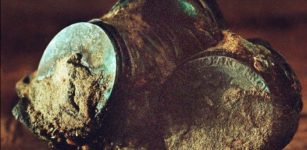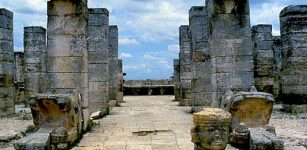Polycarp Of Smyrna: Burned At The Stake And Pierced With A Dagger
A. Sutherland - AncientPages.com - At the moment of his terrible death, Polycarp of Smyrna – one of the Apostolic Fathers and the most exceptional leader of the 2nd century Church - was at least a 86-year-old man.
"He who grants me to endure the fire will enable me also to remain on the pyre unmoved, without the security you desire from nails."
He is considered the last surviving person to have known an apostle, having been a disciple of St. John the Apostle.
Polycarp: Pupil Of The Son Of Thunder
Who was the man that stirred up so much hatred among the non-Christians of Smyrna?
His place of birth is not precisely known, but most probably, he came into the world in 69 AD in Asia, since we know he was sent to Smyrna (today the city of Izmir in Turkey) for studies. Smyrna - which competed with Ephesus and Pergamum for the title "First City of Asia" - has a long history. It was one of the principal cities of Roman Asia. A Christian church was one of the seven churches addressed in the Book of Revelation.
As a boy, Polycarp was taken into the care of St. John Apostle, for whom Polycarp became a beloved disciple. He was raised and formed in faith by one of the Sons of Thunder, who according to Mark 3:17 were James son of Zebedee and his brother John (to them he gave the name Boanerges, which means "sons of thunder"), and it was John who appointed him bishop of the Church in Smyrna.
Polycarp was highly respected as a teacher and church leader. Numerous historical testimonies confirm that he performed exemplary duties of his office.
Time of Persecution
Christian missionaries and converts to Christianity have both been targets of persecution, sometimes to the point of being martyred for their faith, ever since the emergence of Christianity.
In AD 95, Domitian, Emperor of Rome AD 81-96, started a persecution of the Church, and the Apostle John (also called John the Apostle, John the Revelator, John the Divine) was condemned by Domitian to be cast into a cauldron of boiling oil, still, the oil did not harm him, so Domitian banished him to labor in the mines on the isle of Patmos, where he wrote the famous ‘Book of Revelation’.
When the persecution against Christians had increased across the Roman Empire, Polycarp became the next offer, though, for many years, he was spared. He was forced to hide but was finally found. He made no effort to flee again; instead, he greeted the soldiers calmly and explained that he knew what they were coming for and that he was ready to die.
Tradition has it, he even invited them to dinner, and only asked for an hour of prayer. There was so much passion in his prayer that the soldiers regretted they were the ones who had to arrest him.
Moments Before Polycarp’s Death
Then, Polycarp was put on trial in Smyrna and confessed that he had served Jesus Christ for many years and had no intention of abandoning his faith.
The judge offered him what was the custom of the imperial authorities of the time: deny Christ, blaspheme him, and light incense in honor of our gods, and you shall live. Polycarp didn't want to live, at least not according to the Pagan rules. He wanted to achieve the eternal life that awaited him far from suffering on earth.
He rejected the proposal that was given to him and instead the brave old man said:
"For 86 years I have served him, and he has done me no wrong; how then can I blaspheme my King who saved me?"
"Eighty-six years I have served Christ and He has done me no wrong. How then can I blaspheme my King who has saved me?"
The judge threatened Polycarp that he would be burned alive, to which the arrested willingly agreed because he was not afraid of the fire and the death. Soldiers then tried to nail him to a stake, but Polycarp stopped them, saying:
"Leave me as I am. For he who grants me to endure the fire will enable me also to remain on the pyre unmoved, without the security you desire from nails..."
The pile was set on fire, and flames surrounded Polycarp’s body without touching or harming the body. Furious pagans saw that that the fire failed to consume his body, so they commanded an executioner to pierce the body of Polycarp with a dagger, and so was finally done.
Legend says that blood poured from his chest so profusely that it put out the fire.
He was martyred in about 168 AD and the Church commemorates St. Polycarp of Smyrna on February 23.
The date of Polycarp's death is in dispute. According to A historian of Christianity, Eusebius of Caesarea proposed that Polycarp's’ death took place c. 166–167 AD, but another theory is that Saint Polycarp died at the time of persecution of Christians Emperor Marcus Aurelius (121 - 180).
The files of his martyrdom state that it happened on February 22, 156, although he also gives the year 156. The earlier date better fits the tradition of his associations, especially with John the Evangelist, who was by Christians traditionally identified with John the Apostle (or John of Patmos).
Written by – A. Sutherland - AncientPages.com Senior Staff Writer
Copyright © AncientPages.com All rights reserved. This material may not be published, broadcast, rewritten or redistributed in whole or part without the express written permission of AncientPages.com
Expand for referencesReferences:
Long, Stephen. Polycarp Disciple of the Apostle John and the Second Century Church
More From Ancient Pages
-
 We Need To Look Underwater To Understand Our Past – New Study
Archaeology | Apr 14, 2023
We Need To Look Underwater To Understand Our Past – New Study
Archaeology | Apr 14, 2023 -
 Advanced Ancient Knowledge Of Chemistry – From Chrome Plating To Nanotubes
Ancient Technology | Jun 12, 2019
Advanced Ancient Knowledge Of Chemistry – From Chrome Plating To Nanotubes
Ancient Technology | Jun 12, 2019 -
 Horned Serpent – Unusual Ancient Creature Encountered Worldwide – Can Archaeological Finds Confirm Thousand-Year-Old Myths Again?
Ancient Mysteries | Apr 15, 2025
Horned Serpent – Unusual Ancient Creature Encountered Worldwide – Can Archaeological Finds Confirm Thousand-Year-Old Myths Again?
Ancient Mysteries | Apr 15, 2025 -
 Radiocarbon Dating Sheds Light On Historical Events In The Ancient City Of Gezer
Archaeology | Nov 15, 2023
Radiocarbon Dating Sheds Light On Historical Events In The Ancient City Of Gezer
Archaeology | Nov 15, 2023 -
 Remarkable Giant Minoan Structure Found On Top Of Papoura Hill, Crete
Archaeology | Jun 11, 2024
Remarkable Giant Minoan Structure Found On Top Of Papoura Hill, Crete
Archaeology | Jun 11, 2024 -
 Ankhesenamun – Mysterious Death Of Tutankhamun’s Wife Ended The True Amarna Bloodline
Featured Stories | Mar 23, 2018
Ankhesenamun – Mysterious Death Of Tutankhamun’s Wife Ended The True Amarna Bloodline
Featured Stories | Mar 23, 2018 -
 Geri And Freki: Two Wolves ‘Greedy’ And ‘Ravenous’ Were Loyal Companions Of Odin In Norse Beliefs
Featured Stories | Feb 8, 2019
Geri And Freki: Two Wolves ‘Greedy’ And ‘Ravenous’ Were Loyal Companions Of Odin In Norse Beliefs
Featured Stories | Feb 8, 2019 -
 Mystery Of Famous Viking Ruler Rollo: DNA Experts Seek The Truth About His Identity
Featured Stories | Mar 16, 2016
Mystery Of Famous Viking Ruler Rollo: DNA Experts Seek The Truth About His Identity
Featured Stories | Mar 16, 2016 -
 Ancient Mothers Cared For Kids Better Than Previously Thought
Archaeology | Nov 29, 2021
Ancient Mothers Cared For Kids Better Than Previously Thought
Archaeology | Nov 29, 2021 -
 Telangana And Great Ancient Iron Masterwork Of Skilled Blacksmiths Of India
Ancient Technology | May 26, 2017
Telangana And Great Ancient Iron Masterwork Of Skilled Blacksmiths Of India
Ancient Technology | May 26, 2017 -
 2,300-Year-Old Tablet Found In Mugla, Turkey – Region Of Great Historical Importance In Ancient Times
Archaeology | Jun 5, 2019
2,300-Year-Old Tablet Found In Mugla, Turkey – Region Of Great Historical Importance In Ancient Times
Archaeology | Jun 5, 2019 -
 ‘Chac Mool’ – Intriguing Life-Size Figure Carved In Single Stone
Featured Stories | Mar 5, 2016
‘Chac Mool’ – Intriguing Life-Size Figure Carved In Single Stone
Featured Stories | Mar 5, 2016 -
 1,300-Year-Old Mayan Maize God Sculpture Found in Palenque, Mexico
Archaeology | Jun 2, 2022
1,300-Year-Old Mayan Maize God Sculpture Found in Palenque, Mexico
Archaeology | Jun 2, 2022 -
 Voice Belonging To 3,000-Year-Old Egyptian Mummified Priest – Recreated
Archaeology | Jan 28, 2020
Voice Belonging To 3,000-Year-Old Egyptian Mummified Priest – Recreated
Archaeology | Jan 28, 2020 -
 Why Some Stories About Ancient Roman Emperor Nero Are Wrong
Featured Stories | Nov 21, 2016
Why Some Stories About Ancient Roman Emperor Nero Are Wrong
Featured Stories | Nov 21, 2016 -
 Rare Archaeological Discoveries In The Sacred Animal Necropolis In Saqqara
Archaeology | Apr 26, 2020
Rare Archaeological Discoveries In The Sacred Animal Necropolis In Saqqara
Archaeology | Apr 26, 2020 -
 Unknown Ancient Structures Discovered At Machu Picchu By LIDAR
Archaeology | Mar 29, 2022
Unknown Ancient Structures Discovered At Machu Picchu By LIDAR
Archaeology | Mar 29, 2022 -
 Byzantine Granary With 11 Pithoi Found In Byzantine City Of Amorium In Central Turkey
Archaeology | Aug 5, 2020
Byzantine Granary With 11 Pithoi Found In Byzantine City Of Amorium In Central Turkey
Archaeology | Aug 5, 2020 -
 Unsolved Archaeological Mystery Of Ta Prohm Temple, Cambodia
Civilizations | Sep 3, 2018
Unsolved Archaeological Mystery Of Ta Prohm Temple, Cambodia
Civilizations | Sep 3, 2018 -
 Odd Ancient Dwellings Of The Snake People – American-European Connection Part 1
Ancient Mysteries | Sep 6, 2020
Odd Ancient Dwellings Of The Snake People – American-European Connection Part 1
Ancient Mysteries | Sep 6, 2020



